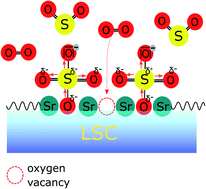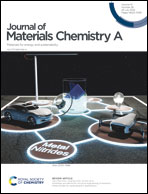In situ techniques reveal the true capabilities of SOFC cathode materials and their sudden degradation due to omnipresent sulfur trace impurities†
Abstract
In this study, five different mixed conducting cathode materials were grown as dense thin films by pulsed laser deposition (PLD) and characterized via in situ impedance spectroscopy directly after growth inside the PLD chamber (i-PLD). This technique enables quantification of the oxygen reduction kinetics on pristine and contaminant-free mixed conducting surfaces. The measurements reveal excellent catalytic performance of all pristine materials with polarization resistances being up to two orders of magnitude lower than those previously reported in the literature. For instance, on dense La0.6Sr0.4CoO3−δ thin films, an area specific surface resistance of ∼0.2 Ω cm2 at 600 °C in synthetic air was found, while values usually >1 Ω cm2 are measured in conventional ex situ measurement setups. While surfaces after i-PLD measurements were very clean, ambient pressure X-ray photoelectron spectroscopy (AP-XPS) measurements found that all samples measured in other setups were contaminated with sulfate adsorbates. In situ impedance spectroscopy during AP-XPS revealed that already trace amounts of sulfur present in high purity gases accumulate quickly on pristine surfaces and lead to strongly increased surface polarization resistances, even before the formation of a SrSO4 secondary phase. Accordingly, the inherent excellent catalytic properties of this important class of materials were often inaccessible so far. As a proof of concept, the fast kinetics observed on sulfate-free surfaces were also realized in ex situ measurements with a gas purification setup and further reduces the sulfur concentration in the high purity gas.



 Please wait while we load your content...
Please wait while we load your content...